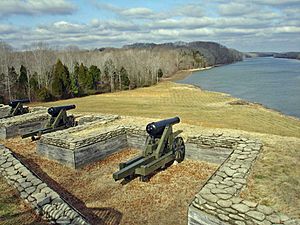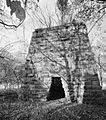National Register of Historic Places listings in Stewart County, Tennessee facts for kids
This article is about the cool places in Stewart County, Tennessee that are listed on the National Register of Historic Places. Think of the National Register as a special list of important buildings, places, and sites in the United States that are worth preserving because of their history.
Stewart County has 16 places on this list! A lot of them, ten to be exact, are the old ruins of iron furnaces. Back in the 1800s, Stewart County was a really big deal for making iron. People started making iron there before 1828, and it kept going until 1927. All the iron furnaces in the county were "stone stack" furnaces. This means they were made of stone and used charcoal (which comes from burning wood from local forests) to melt the iron.
| Anderson – Bedford – Benton – Bledsoe – Blount – Bradley – Campbell – Cannon – Carroll – Carter – Cheatham – Chester – Claiborne – Clay – Cocke – Coffee – Crockett – Cumberland – Davidson – Decatur – DeKalb – Dickson – Dyer – Fayette – Fentress – Franklin – Gibson – Giles – Grainger – Greene – Grundy – Hamblen – Hamilton – Hancock – Hardeman – Hardin – Hawkins – Haywood – Henderson – Henry – Hickman – Houston – Humphreys – Jackson – Jefferson – Johnson – Knox – Lake – Lauderdale – Lawrence – Lewis – Lincoln – Loudon – Macon – Madison – Marion – Marshall – Maury – McMinn – McNairy – Meigs – Monroe – Montgomery – Moore – Morgan – Obion – Overton – Perry – Pickett – Polk – Putnam – Rhea – Roane – Robertson – Rutherford – Scott – Sequatchie – Sevier – Shelby – Smith – Stewart – Sullivan – Sumner – Tipton – Trousdale – Unicoi – Union – Van Buren – Warren – Washington – Wayne – Weakley – White – Williamson – Wilson |
Historic Iron Furnaces
Stewart County was once a busy place for making iron. Imagine huge stone structures where workers would melt iron ore to create new metal! These places were called iron furnaces. Ten of the historic sites in Stewart County are the remains of these old furnaces.
How Iron Furnaces Worked
These furnaces were often called "cold-blast" furnaces. This means they didn't use hot air to help the melting process, unlike later furnaces. They used charcoal, which was made by burning wood from the many forests in the area. The iron ore, charcoal, and limestone were put into the top of the tall stone furnace. Inside, the charcoal would burn super hot, melting the iron ore. The melted iron would then flow out the bottom.
Important Iron Furnace Sites
Many of these old furnaces are now ruins, but they tell an important story about how people lived and worked long ago. Some of the furnaces on the National Register include:
- Bear Spring Furnace: Located near Dover, this was one of the many furnaces that helped make Stewart County an iron-producing center.
- Clark Furnace: Found near Standing Rock, this furnace also played a role in the county's iron industry.
- Eclipse Furnace: Situated near McKinnon, this furnace was another key part of the iron-making history.
- Great Western Furnace: This large furnace near Dover was very important for iron production in the region.
- LaGrange Furnace: Also near McKinnon, this furnace is another example of the county's industrial past.
Civil War Battlefields
Stewart County was also a very important place during the American Civil War. Two major forts, Fort Donelson and Fort Henry, were built there. These forts were crucial because they controlled important rivers, the Cumberland and Tennessee Rivers.
Fort Donelson National Battlefield
Fort Donelson is a famous Civil War site located near Dover. It was a very important battleground. In February 1862, Union forces led by Ulysses S. Grant fought a big battle here against Confederate soldiers. The Union victory at Fort Donelson was a major turning point in the war, giving the Union control of key rivers. Today, you can visit the battlefield and learn all about what happened there. It's a place where history really comes alive!
Fort Henry Site
Fort Henry was another important fort, located northwest of Dover. It was built on the Tennessee River. Just before the Battle of Fort Donelson, Union forces also captured Fort Henry. This gave the Union control over the Tennessee River, which was a big advantage. While not as well-preserved as Fort Donelson, the site of Fort Henry is still recognized for its historical importance.
Other Historic Places
Besides the iron furnaces and Civil War sites, Stewart County has other interesting places on the National Register.
Dover Flint Quarries
The Dover Flint Quarries are an ancient site near Dover. For thousands of years, Native Americans came to these quarries to find flint. Flint is a type of stone that can be shaped into tools, arrowheads, and other useful items. This site shows us how people lived and used the land long, long ago.
Historic Homes
There are also a couple of historic homes listed:
- Henry Hollister House: This house, located on Chapel Ridge Road near Cumberland City, is an example of the architecture and lifestyle from a past era in the county.
- Samuel Stacker House: Found on Long Branch Road near Dover, this house also gives us a peek into the history of homes in Stewart County.
These places help us remember and understand the rich history of Stewart County, from its early industries to its role in major national events.
Images for kids








